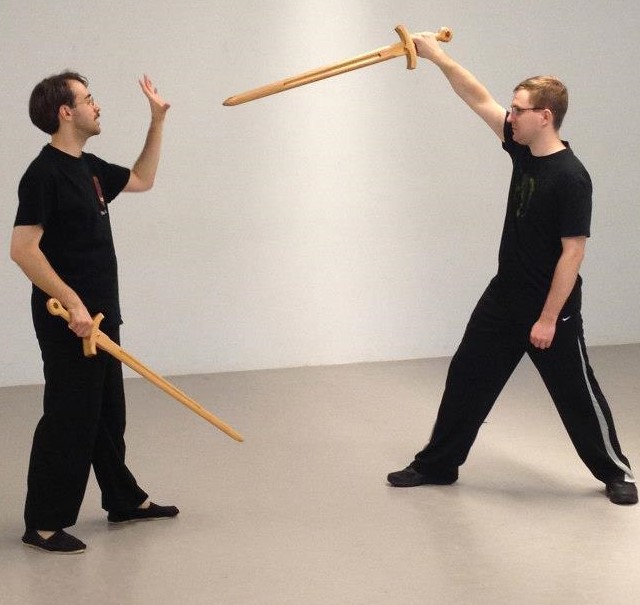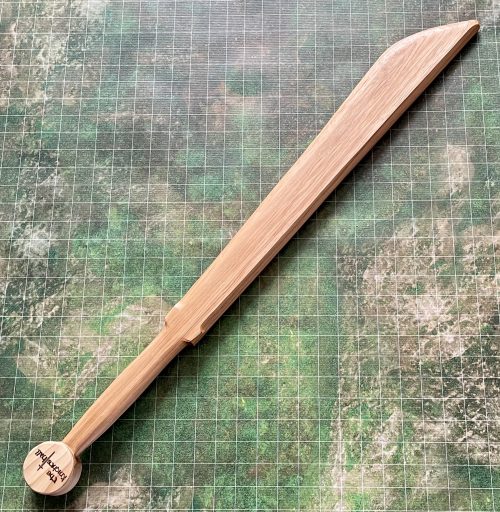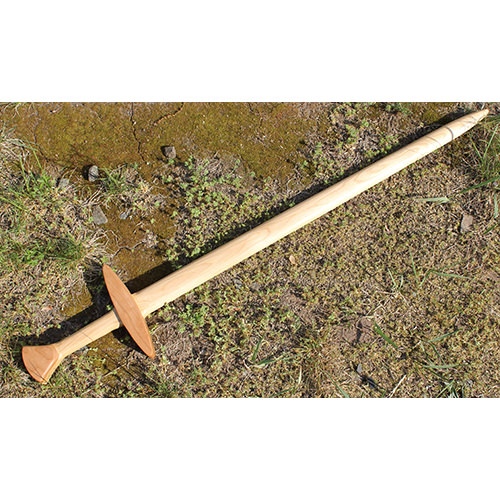-
 Length: Overall - 38.5", Blade - 28", Handle - 6.75" This is an Intermediate-level sword, appropriate for younger or less experienced swordspeople. The archer’s primary weapon was the bow and arrow, but what did an archer turn to when the enemy closed and tried to engage the archer in melee combat? In such a situation, the archer typically favored a short sword, just like this one, something lighter than a full-sized blade, but effective against a more heavily armed and armored foe.
Length: Overall - 38.5", Blade - 28", Handle - 6.75" This is an Intermediate-level sword, appropriate for younger or less experienced swordspeople. The archer’s primary weapon was the bow and arrow, but what did an archer turn to when the enemy closed and tried to engage the archer in melee combat? In such a situation, the archer typically favored a short sword, just like this one, something lighter than a full-sized blade, but effective against a more heavily armed and armored foe. -
 The Claymore Sword better known as the great sword of the Highlands, was used in the constant clan warfare and border fights with the English from 1500 to 1650 and was still in use as late as the Rebellion of 1745, the two-handed Claymore Sword seems to be an offshoot of earlier broadswords as they were developed into great swords. Widely feared because its lightness made it faster in combat than European counterparts, the Claymore Sword developed a distinctive style of cross guard with down-sloping arms that ended in spatulate swellings.
The Claymore Sword better known as the great sword of the Highlands, was used in the constant clan warfare and border fights with the English from 1500 to 1650 and was still in use as late as the Rebellion of 1745, the two-handed Claymore Sword seems to be an offshoot of earlier broadswords as they were developed into great swords. Widely feared because its lightness made it faster in combat than European counterparts, the Claymore Sword developed a distinctive style of cross guard with down-sloping arms that ended in spatulate swellings. -
 The Shaska in appearance is midway between a full sabre and a straight sword. This sabre was preferred by Russian calvary, Cossacks, and later became the official weapon for Russian troops and police. It has a slightly curved blade and can be effective for both slashing and thrusting. There is no guard, but a large curved pommel. Overall length is 36" with a 29" blade.
The Shaska in appearance is midway between a full sabre and a straight sword. This sabre was preferred by Russian calvary, Cossacks, and later became the official weapon for Russian troops and police. It has a slightly curved blade and can be effective for both slashing and thrusting. There is no guard, but a large curved pommel. Overall length is 36" with a 29" blade. -
 Length: Overall 15, Blade 10”, Handle 3.5 “, ¾” thick A dagger is a knife fighting weapon with a very sharp point designed or capable of being used as a thrusting or stabbing weapon.[1][2] The design dates to human prehistory, and daggers have been used throughout human experience to the modern day in close combat confrontations.
Length: Overall 15, Blade 10”, Handle 3.5 “, ¾” thick A dagger is a knife fighting weapon with a very sharp point designed or capable of being used as a thrusting or stabbing weapon.[1][2] The design dates to human prehistory, and daggers have been used throughout human experience to the modern day in close combat confrontations. -
 Length: Overall 26”, Blade 20”, Handle 6” Czech tusk (Dussack) – specific weapon for Czech very common for farmers, artisans, etc. Originates from the Husitian wars in Czech in the first half of the 15th century. Later the style evolved into a wooden version used for training. Pictured is a Dussak with black walnut trim on the handle, optional.
Length: Overall 26”, Blade 20”, Handle 6” Czech tusk (Dussack) – specific weapon for Czech very common for farmers, artisans, etc. Originates from the Husitian wars in Czech in the first half of the 15th century. Later the style evolved into a wooden version used for training. Pictured is a Dussak with black walnut trim on the handle, optional. -

 Length: Overall 52", Blade 38", Handle 10" Great swords are infantry swords which cannot be used comfortably in a single-hand. For the most part, they were scaled-up versions of the longsword. Great swords were capable of facing heavier weapons such as pole-arms and larger axes, and were devastating against light armour.
Length: Overall 52", Blade 38", Handle 10" Great swords are infantry swords which cannot be used comfortably in a single-hand. For the most part, they were scaled-up versions of the longsword. Great swords were capable of facing heavier weapons such as pole-arms and larger axes, and were devastating against light armour. -
 Length: Overall 36”, Blade 29”, Handle 6” The German Gross Messer had a reputation for being a huge and imposing battle ready sword. Gross Messers (German for “Great Knife”) are a Renaissance creation originating around the 15th century. With the need of swords serving both military and civilian life, the messer became a utility tool for daily activity, hunting, self-protection and war.
Length: Overall 36”, Blade 29”, Handle 6” The German Gross Messer had a reputation for being a huge and imposing battle ready sword. Gross Messers (German for “Great Knife”) are a Renaissance creation originating around the 15th century. With the need of swords serving both military and civilian life, the messer became a utility tool for daily activity, hunting, self-protection and war. -

 Medieval longswords are the classic hand and a half sword or war sword of the 14th and 15th centuries. The hand and a half sword was typically straight, double-edged, with a simple cruciform hilt. It grew naturally out of the older, single-handed sword, as a means of combating heavier chain mail, and reinforced chain mail armour. Overall length of the longsword is 47", blade length is 35" and handle is 8".
Medieval longswords are the classic hand and a half sword or war sword of the 14th and 15th centuries. The hand and a half sword was typically straight, double-edged, with a simple cruciform hilt. It grew naturally out of the older, single-handed sword, as a means of combating heavier chain mail, and reinforced chain mail armour. Overall length of the longsword is 47", blade length is 35" and handle is 8". -

 Length: Overall 40”, Blade 31”, Handle 5” A sword with a broad blade and usually two lethal cutting edges. The Broadsword was used to cut rather than stab. The Normans (also called Northmen or Norsemen) were the descendants of the Scandinavian Vikings who raided the European coastal settlements at the outset of the 8th century. Despite the Norman's conversion to Christianity and their adoption of Frankish way of life, the Normans retained many of the traits of their Germanic ancestors.
Length: Overall 40”, Blade 31”, Handle 5” A sword with a broad blade and usually two lethal cutting edges. The Broadsword was used to cut rather than stab. The Normans (also called Northmen or Norsemen) were the descendants of the Scandinavian Vikings who raided the European coastal settlements at the outset of the 8th century. Despite the Norman's conversion to Christianity and their adoption of Frankish way of life, the Normans retained many of the traits of their Germanic ancestors. -
 This is an Intermedial-level sword, appropriate for younger or less experienced swordspeople. A sword with a broad blade and usually two lethal cutting edges. The Broadsword was used to cut rather than stab. The Normans (also called Northmen or Norsemen) were the descendants of the Scandinavian Vikings who raided the European coastal settlements at the outset of the 8th century. Despite the Norman's conversion to Christianity and their adoption of Frankish way of life, the Normans retained many of the traits of their Germanic ancestors.
This is an Intermedial-level sword, appropriate for younger or less experienced swordspeople. A sword with a broad blade and usually two lethal cutting edges. The Broadsword was used to cut rather than stab. The Normans (also called Northmen or Norsemen) were the descendants of the Scandinavian Vikings who raided the European coastal settlements at the outset of the 8th century. Despite the Norman's conversion to Christianity and their adoption of Frankish way of life, the Normans retained many of the traits of their Germanic ancestors. -

 The Knights Hall Armored Combat Training Systems Kit: The Waster / Pell Trainer Hickory arming sword trainer with The Knights Hall lasered on the pommel. Arming Sword overall length is .34.5". The pell trainer is available as the arming sword, longsword, falchion, and great sword.
The Knights Hall Armored Combat Training Systems Kit: The Waster / Pell Trainer Hickory arming sword trainer with The Knights Hall lasered on the pommel. Arming Sword overall length is .34.5". The pell trainer is available as the arming sword, longsword, falchion, and great sword. -

 The Knights Hall Armored Combat Training Systems Kit: The Waster / Pell Trainer Hickory Falchion sword trainer with The Knights Hall lasered on the pommel. Falchion overall length is 34". The pell trainer is available as the arming sword, longsword, falchion, and great sword.
The Knights Hall Armored Combat Training Systems Kit: The Waster / Pell Trainer Hickory Falchion sword trainer with The Knights Hall lasered on the pommel. Falchion overall length is 34". The pell trainer is available as the arming sword, longsword, falchion, and great sword. -

 The Knights Hall Armored Combat Training Systems Kit: The Waster / Pell Trainer Hickory Great sword trainer with The Knights Hall lasered on the pommel. Great sword overall length is 52". The pell trainer is available as the arming sword, longsword, falchion, and great sword.
The Knights Hall Armored Combat Training Systems Kit: The Waster / Pell Trainer Hickory Great sword trainer with The Knights Hall lasered on the pommel. Great sword overall length is 52". The pell trainer is available as the arming sword, longsword, falchion, and great sword. -

 The Knights Hall Armored Combat Training Systems Kit: The Waster / Pell Trainer Hickory Longsword trainer with The Knights Hall lasered on the pommel. Longsword overall length is 47". The pell trainer is available as the arming sword, longsword, falchion, and great sword.
The Knights Hall Armored Combat Training Systems Kit: The Waster / Pell Trainer Hickory Longsword trainer with The Knights Hall lasered on the pommel. Longsword overall length is 47". The pell trainer is available as the arming sword, longsword, falchion, and great sword. -

 Musketeer Rapier, 46" overall, 37.5" blade, with wood guard and round leather guard below guard. You can order the rapier with or without leather basket and hand and a half (pictured) or single handed handle. Because it allowed for fast reactions and had a long reach, the rapier was well-suited to civilian combat during the 16th and 17th Centuries. Rapiers were common among bodyguards like the elite French Royal Guards or Swiss Papal Guards, especially since they needed a weapon that could be used indoors or in crowded areas.
Musketeer Rapier, 46" overall, 37.5" blade, with wood guard and round leather guard below guard. You can order the rapier with or without leather basket and hand and a half (pictured) or single handed handle. Because it allowed for fast reactions and had a long reach, the rapier was well-suited to civilian combat during the 16th and 17th Centuries. Rapiers were common among bodyguards like the elite French Royal Guards or Swiss Papal Guards, especially since they needed a weapon that could be used indoors or in crowded areas. -
 Length: Overall 35” Blade 27 ¾” Handle 6” This weapon was a type of sword most commonly associated with the Saracens in the Holy Land who fought against the Crusaders. The Scimitar was used for slicing attacks and often used from horseback.. Scimitars had a distinct curved blade ending with a sharp point.
Length: Overall 35” Blade 27 ¾” Handle 6” This weapon was a type of sword most commonly associated with the Saracens in the Holy Land who fought against the Crusaders. The Scimitar was used for slicing attacks and often used from horseback.. Scimitars had a distinct curved blade ending with a sharp point. -
 Our sparring dagger or parrying dagger is a category of small handheld weapons from the European late Middle Ages and early Renaissance. These weapons were used as off-hand weapons in conjunction with a single-handed sword. As the name implies they were designed to parry, or defend, more effectively than a simple dagger form, typically incorporating a wider guard, and often some other defensive features to better protect the hand as well.
Our sparring dagger or parrying dagger is a category of small handheld weapons from the European late Middle Ages and early Renaissance. These weapons were used as off-hand weapons in conjunction with a single-handed sword. As the name implies they were designed to parry, or defend, more effectively than a simple dagger form, typically incorporating a wider guard, and often some other defensive features to better protect the hand as well. -
 Length: Overall 33.5”, Blade 25.5”, Handle 4” This is an Intermedial-level sword, appropriate for younger or less experienced swordspeople. Initially, squires were a knight’s trainees/apprentices. A knight typically took his squire into battle and gave him a chance to prove himself. If he proved his loyalty and skill in battle, he would have a “dubbing”, an official ceremony that made him a knight. Great for a first sword, the squire sword helps to improve arm strength and technique.
Length: Overall 33.5”, Blade 25.5”, Handle 4” This is an Intermedial-level sword, appropriate for younger or less experienced swordspeople. Initially, squires were a knight’s trainees/apprentices. A knight typically took his squire into battle and gave him a chance to prove himself. If he proved his loyalty and skill in battle, he would have a “dubbing”, an official ceremony that made him a knight. Great for a first sword, the squire sword helps to improve arm strength and technique. -

 The Zweihander (two-handed) sword is not for the faint of heart...called the Great Landsknecht Swords, they were wielded by only the strongest and most fearless chosen front line Swiss and German soldiers of the Middle Ages. Its main purpose was to down charging horsemen and cut off oncoming pike heads. Dimensions are overall 55", blade length is 39.5", handle 13", and the guard is 10" wide! The parrying hooks are keyed for added ruggedness. See below for Goliath Zweihander orders!
The Zweihander (two-handed) sword is not for the faint of heart...called the Great Landsknecht Swords, they were wielded by only the strongest and most fearless chosen front line Swiss and German soldiers of the Middle Ages. Its main purpose was to down charging horsemen and cut off oncoming pike heads. Dimensions are overall 55", blade length is 39.5", handle 13", and the guard is 10" wide! The parrying hooks are keyed for added ruggedness. See below for Goliath Zweihander orders!







